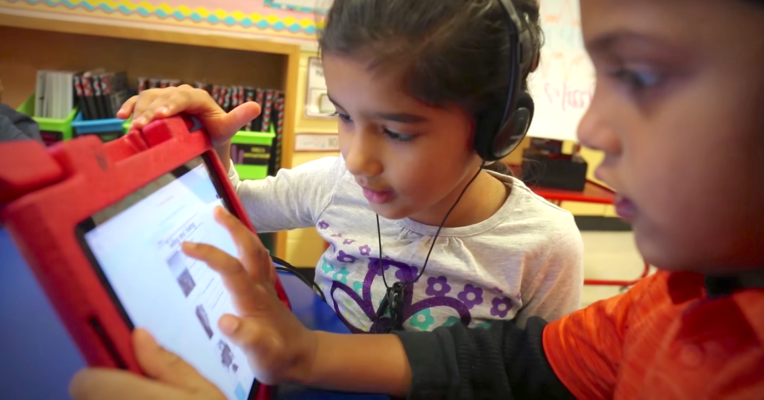Kids don’t try their hardest unless they think someone’s watching. Overcrowded classrooms and distracted parents can make pouring effort into school work feel pointless. But Seesaw‘s app turns their assignments into social media they share with teachers, peers and mom and dad. Now it’s invading schools across the country and just raised a Series A round from LinkedIn CEO Jeff Weiner and others.
On Seesaw, instead of racking up likes or receiving comments on a selfie, students get positive reinforcement on their quizzes, drawings and science projects. And for instructors, Seesaw serves as extra eyes, allowing them to focus on managing the classroom, then later watch self-recorded videos of students completing a task or working through a question.
By getting kids to care about classwork and giving teachers a closer look at their students’ process not just output, Seesaw has quietly become one of the most popular learning tools for elementary school students. Now half of all U.S. schools have teachers using Seesaw, up from one-quarter in June 2016 when we profiled the education startup. Millions of students now use Seesaw each month in 150 countries. And the startup has 1,000 schools and districts paying for the premium version of Seesaw.
“Most elementary school products are dumbed-down versions of high school products,” says co-founder Carl Sjogreen. Seesaw’s design relies on big, obvious buttons and the familiar camera feature most kids are already used to playing with. This makes creative projects easier to assign and more rewarding thanks to digital show-and-tell. Kids don’t feel like their assignments just end up in the trash once hastily graded. “Much of the traditional classroom is about getting kids to express themselves through a worksheet. Can you think of a more constraining way to create than fill in the blank on a worksheet?”
Seesaw was co-founded by Adrian Graham and Sjogreen, a former Facebook director of product management who had sold it his travel startup NextStop. He launched a social app called Shadow Puppet in 2013 as a way to record voice-over for photo slideshows. This was a cool idea back before Snapchat Stories had even launched, and it raised money from Greylock’s Discover fund.
While Shadow Puppet flopped with consumers, some teachers and students loved using it for showing off class projects. Nine months in, he pivoted Shadow Puppet and Seesaw launched in 2015. Now it’s picking up steam with its Series A of an undisclosed size from investors, including LinkedIn’s CEO, former DFJ partner Bubba Murarka and Wayee Chu of Reach Capital. Some of that cash went to hiring Mike Wu, former CTO of Instagram competitor VSCO, as Seesaw’s VP of engineering.
Social media for students
Seesaw offers iOS, Android, Kindle, Chromebook and web apps where kids can share photos, videos, drawings, notes, links, files and blogs, and record voice-overs explaining their work. First they go to the teacher, who must approve the content as safe before it’s exposed to other students. Teachers can grade work, send feedback to students and organize it by class, student or topic. Special education students have particularly benefited from the multimedia options that let them work with their different strengths in speaking or drawing as opposed to writing or video.
Parents can also get notified so they actually know what’s going on with their kids, even if no assignments make it home in their backpacks. Sjogreen says, “The magic moment is instead of ‘Lily, how was school today?’ ‘Fine.’ ‘What’d you do?’ ‘Nothing.’ — I can have a jumping off point for a much richer conversation. ‘Tell me about this thing you made?’ ”
Seesaw is free for students and parents, and teachers can get started without paying, too. But schools and school districts pay if they want to sync Seesaw with their student databases and grading systems, and get centralized administration, analytics and more grading features. They pay $5 per student per year. Seesaw’s 1,000 paying clients include schools with 100 kids as well as districts with tens of thousands. They helped the startup triple its revenue year-over-year.
There are a few concerns with giving kids more “social media” in the classroom. I asked what happens if kids leave a mean comment on someone else’s work. But Sjogreen says comments have to go through teacher moderation too, and can produce learning opportunities for kids to understand how to act on the internet.
There’s also the concern that kids spending more time with devices in the classroom could distract them. Most students use Seesaw on school-provided tablets with limited apps and connectivity, though, so there’s no confusing work and play.
Selling to schools is notoriously tough for startups. Luckily, Seesaw’s Dropbox-style bottom-up distribution strategy gives the product away to teachers until a school feels like they might as well bake Seesaw into their systems. Still, the app has to compete with alternatives like FreshGrade, which is focused on older students and a wide set of grading options.
Some teachers and parents might hope to keep kids off social media for as long as possible, especially during the school day. But there’s no avoiding the fact that creating compelling digital content is critical for a wide array of jobs, whether you’re making marketing material, designing a product, or just giving a PowerPoint presentation. By easing children into this experience with strong oversight from teachers, they could get a head start. And if kids feel like their creativity and intelligence is appreciated, they’ll stay tuned in to all the opportunities academia can offer.
